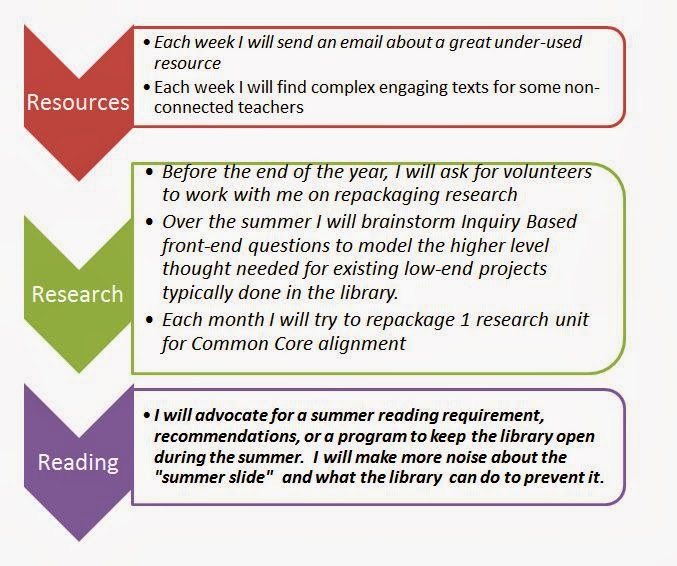From time to time I am asked about the "research" behind the efficacy of the school librarian. I want to take a quick minute to post some of the best resources here for those that may need to share these with budgetary decision makers. (Listed below)
In this issue of Scholastic's Administrator, I have a short article entitled: Your Hidden Asset. Let's hope we're not too hidden! (I did not choose the title). Now, we know that too many administrators just don't frequent your library doors, and Scholastic meant that title figuratively, but let's make it our goal to insure we are seen and heard. The research will not do you much good if you are not connecting to the classroom, kids, and being visible with your principal. Consider some Spring SMART goals for visibility. Here are a few examples:
One of our local elementary librarians, Jen , advocated for bags to enable her to send home 5 books with each student this summer. She works in a high-needs district and commented, "I know some will be lost, but I don't care. We have to work to reduce the summer slide and I know many kids have no books at home." She said she is planning on telling the kids to share and to bring them back. This will be the first year of this program so it will be interesting to see the data on what is lost. Dare we say it will be a small cost compared to the lost reading ground retained?
To find other ways to be seen and hear, order a copy of Make a Big Impact @ Your School Board Meeting. - From Libraries Unlimited.
Here are a list of the white papers for advocacy and more:
- American Association of School Librarians (n.d.). Strong School Libraries Build Strong Students. Click here
- American Association of School Librarians (2012). School Libraries Count: National Longitudinal Study of School Library Programs. A report of the annual online survey of school library programs in the United States. Findings indicate that despite cuts in many areas, school library programs remain consistently strong. However, the survey also indicated that the number of computers outside of the library with networked access to services has significantly increased. The trend is to increase remote access to library licensed databases.
- American Library Association (2007). Libraries Connect Communities: Public Library Funding and Technology Access Study 2006-2007. This survey of technology access in libraries throughout the United States demonstrates that technology is attracting larger numbers of people to public libraries each year. It includes information on children as consumers of technology, especially as users of databases that help with homework.
- American Librarian Association (n.d.). Add It Up: Libraries Make the Difference – Talking Points. These advocacy documents provide readers with talking points in favor of funding of public and school libraries. Public library School library
- Center for International Scholarship in School Libraries (2010; 2011). The New Jersey Study of School Libraries: One Common Goal-Learning. Executive summaries of an intense two-phase study of school libraries in the New Jersey educational program indicating that libraries and librarians contribute to the intellectual life and development of students in complex and diverse ways.
- Krashen, S & Shin, F. (2004). Summer Reading and the Potential Contribution of the Public Library in Improving Reading for Children of Poverty. Public Library Quarterly, 23.3/4, 99-109. Research indicates that there is surprisingly little difference in reading gains between children from high- and low-income families during the school year. Rather, the difference is what happens in the summer. The author stresses the need to expand and improve the services libraries offer to low-income children in order to close the reading achievement gap.
- McClure, C. R. & Bertot, J. C. (1998). Public Library Use in Pennsylvania: Identifying Uses, Benefits, and Impacts.
According to focus groups conducted in Pennsylvania’s urban and rural communities, libraries make specific, unduplicated, and important contributions to the education, socialization, and well being of Pennsylvania's children. - New York Comprehensive Center Educational Technology Team (2012). Informational Brief: The Impact of Public Libraries on Students and Lifelong Learners. Report demonstrates positive impact of public libraries and makes connections to learning across the lifespan. Executive Summary:
- A statement from the New York State Libraries on the importance and roles of librarians and the implementation of the Common Core Learning Standards.
Report indicates that school libraries are critical to student achievement, curriculum development, and instruction.New York State Libraries (2013). Libraries and the Common Core.


No comments:
Post a Comment